I needed to pull the centerboard out of my Whitehall and make it a bit thinner so it would operate more smoothly. I wasn’t looking forward to dragging the boat off the trailer, setting it on the lawn, and rolling it on its side to get at the centerboard. That job really needs one person handling the boat and another managing the trailer. If I could just lift the boat up while it was still on the trailer, it would be a whole lot easier and I could do the job alone. It occurred to me that I could use my inflatable beach rollers as air jacks, like those used by rescue workers to lift wrecked cars. If I could slip the deflated rollers under my boat and then pump them up, they might lift the boat.
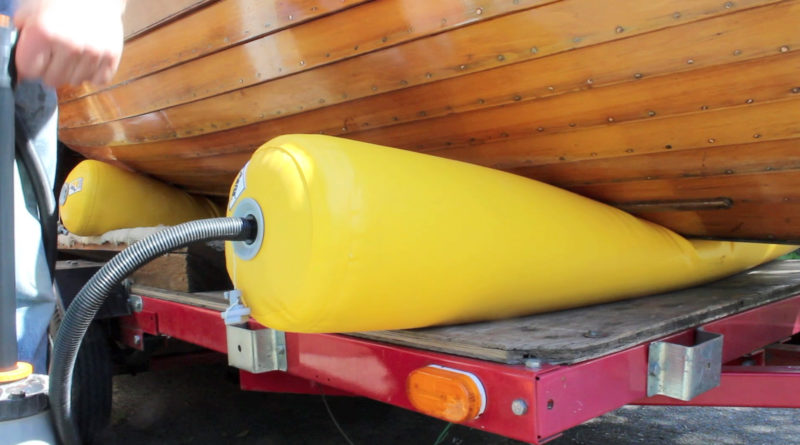
I didn’t know if the pump could handle the air pressure required to lift the boat, but it became evident that the weight, say 200 pounds, would be divided by the contact area, say 25 square inches at the full lift, to bring the pressure down to a manageable 8 psi.
It worked better than I had imagined. The boat will roll—I figured that out when I got some air in the second roller and the Whitehall started to move—so it has to be restrained fore and aft. The pump I used was for rubber rafts and designed for volume, not high pressure, but it was good enough to get the Whitehall raised 7″ or 8″. That wasn’t high enough to drop the board straight down out of the trunk, but the unexpected benefit of using the rollers for the lift was that they cradled the boat while I rolled it to one side to provide enough room to pull the board. All the while the hull was safely supported on the soft, conforming surfaces of the rollers.
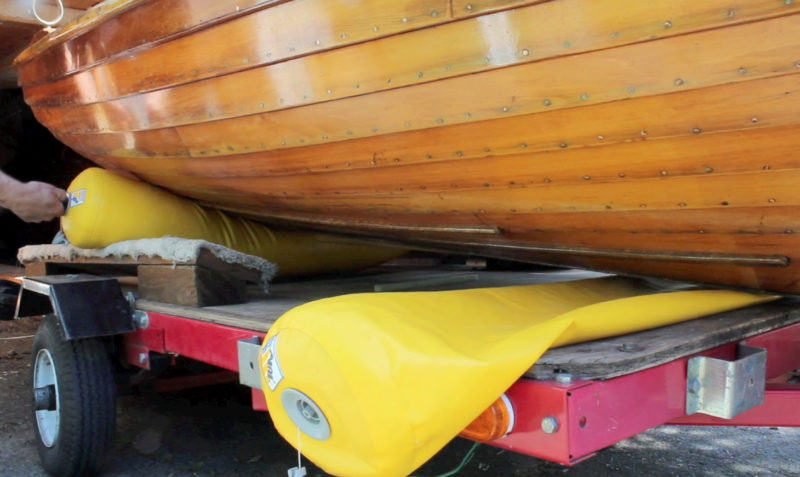
The flatbed trailer provided a good base for the rollers, even when one of them had to conform to the bunk boards.
All it took to lower the boat was pressing the rollers’ valves to bleed off the air. The boat pinned one roller to the deck of the trailer and I couldn’t lift the boat and pull the roller out at the same time. I tied a bungee cord to the roller and stretched it out; when I raised the end of the boat, the roller slipped out.
There may be more heavy lifting ahead for these rollers.![]()
Afterword
My chance to do some more heavy lifting with the rollers came soon enough. I use the same trailer for my Caledonia yawl as I do for my Whitehall, and after I got the Whitehall’s centerboard reinstalled and took it for a few outings, I was ready to take it off of the trailer and put the Caledonia on. After I used the rollers, inflated, to scoot the Whitehall off the trailer, it was time to move the much larger Caledonia. It’s too heavy to slide on the lawn, so I wouldn’t have been able to set a roller at the bow and push the boat up on it, but the bottom has enough rocker that I could slip a deflated roller under the bow. After I had pumped that roller up I had clearance under the middle of the boat to get the second roll, flattened, slipped in. The second roller not only raised the whole boat— lifting close to 400 pounds—it leveled it side to side and kept it stable. It took very little effort then to roll the boat to the trailer and winch it home. When it’s time for the Caledonia to come off the trailer, the rollers will ease it back to the lawn and keep it elevated while I get some blocking under it to keep it off the grass.
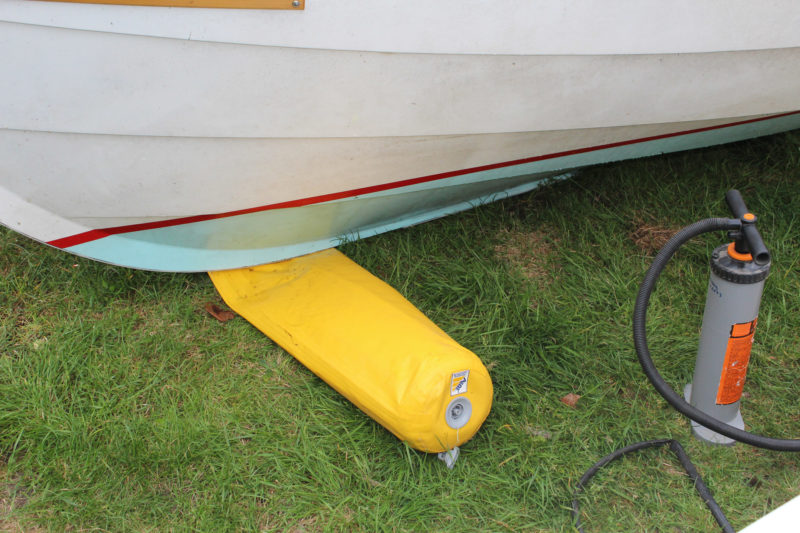
The first roller slipped under the bow
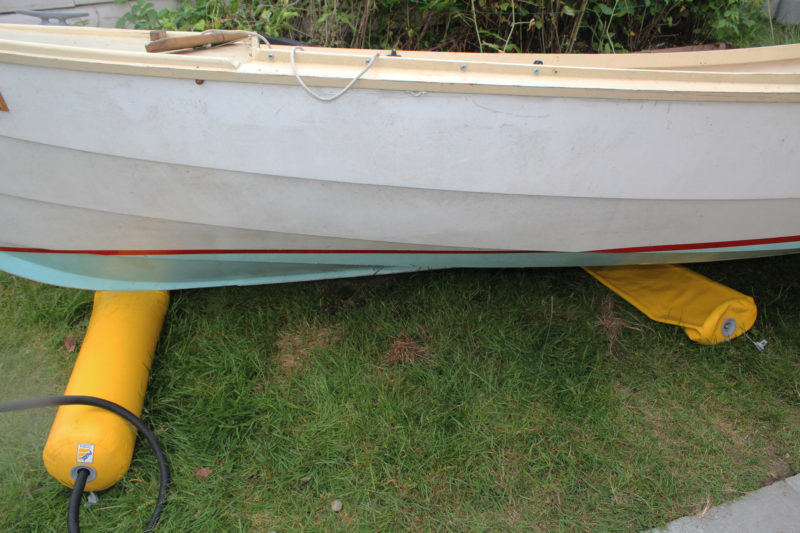
First roller inflated, making room for the second roller to be slipped under closer to amidships

Both rollers inflated, the boat raised, leveled, and ready to roll to the trailer
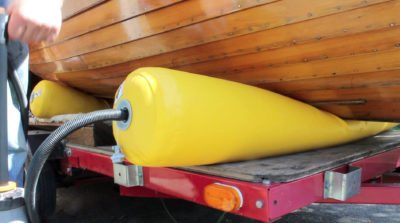
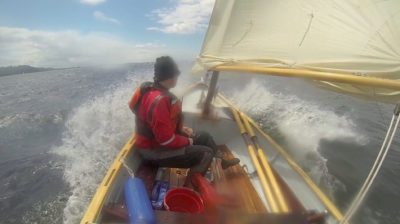
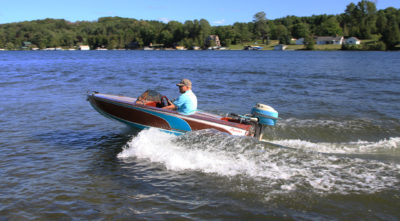
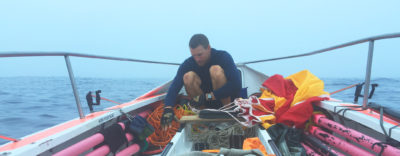
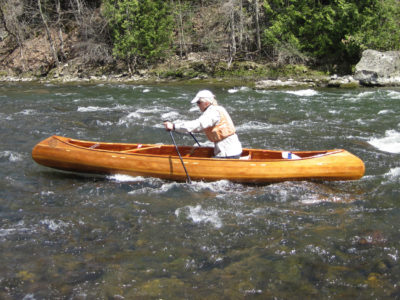
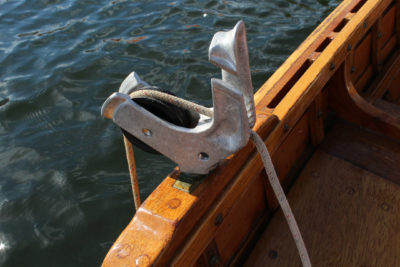
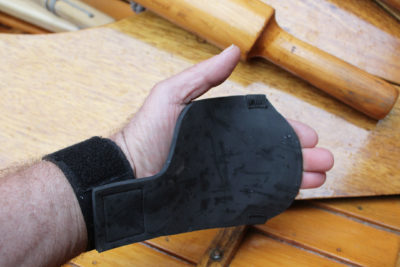


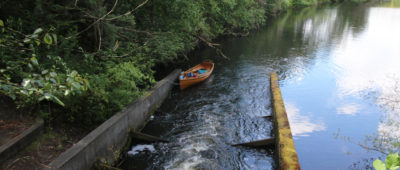

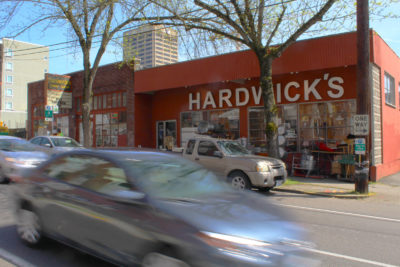
Thanks for this. It’s very helpful. I bought two of these rollers this winter, but I won’t be able to use them as beach rollers until up in Maine late this summer, when I have to get our boat over a rocky beach at low tide. However, they are perfect for adding buoyancy to our 18′ sailing surf dory. They snuggle nicely to the seat risers under the mid thwart, so they can be used even now when we are out on the Potomac. For inflation I’m using a battery-operated blower as the seller recommended, but what kind of air pump are you using? It doesn’t look like something for bicycle tires. I suspect that you can get much more lift with your hand pump than I can with my little, but very portable, blower.
The pump is dual action hand pump that is used for inflating rafts and inflatable kayaks. There are a lot of similar pumps on the web and in sports stores.
I switch boats on trailers pretty often. A line to a convenient tree lets me pull the boat off. I haven’t used my beach rollers for them to land; mostly I’ve used a nice collection of PVC pipe. The real heart of the system is an old fashioned spar cart (at least that is what I was told it was). Mine is a piece of old mast about 8 ” diameter with a hole bored in it. It has a pipe axle which goes into a couple of 2×6 ‘s on edge. They are tapered a bit and lagged into a couple of 2 x 4 cross pieces. The whole affair is set up so that when it is sitting on the frame there is a convenient fixed roller, then when it is turned over it is a cart where the boat is just clear of the roller. Making one out of readily available material is simply a piece of 6″ or 8″ PVC pipe with a couple of discs cut to fit in the ends, drilled for the axles.
I also have a pulley system in my garage set up to a trailer winch which is sometimes handy.
These Aere beach rollers are great! I purchased four rollers and a pump from Duckworks for my 1986 Sea Pearl 21. When they arrived I was very impressed with the quality. In addition to being a great tool for moving/lifting my Sea Pearl, I also use them to add flotation and for docking fenders. The do a great job of protecting the leeboard. Thanks for posting this product review.
Thank you for sharing this innovative “air-lift” technique for small boats! It’s fascinating to learn about different methods to manage and transport boats. I’m curious, are there particular types or sizes of boats for which this air-lift technique is most effective, and are there any specific considerations or adjustments needed for different boat materials or designs?
The concept of an air lift is nothing short of revolutionary. From enhancing water circulation in aquariums to transporting materials in industrial processes, air lifts showcase the ingenious application of compressed air. It’s a powerful and versatile mechanism that defies gravity, making waves in various fields. Here’s to the remarkable efficiency and innovation of air lifts – lifting expectations in the world of fluid dynamics!